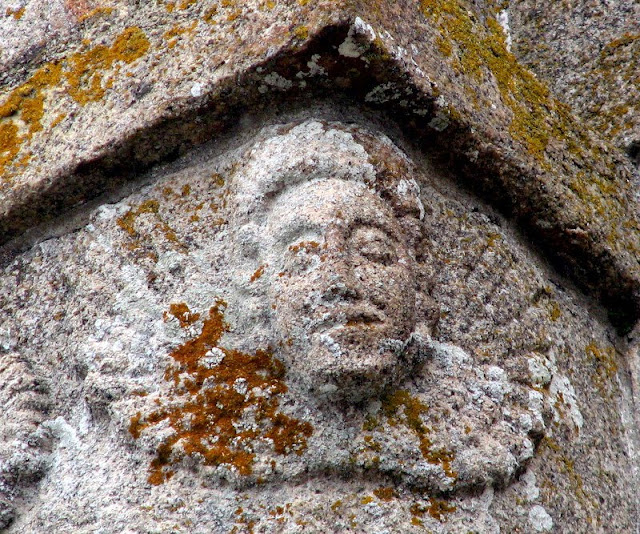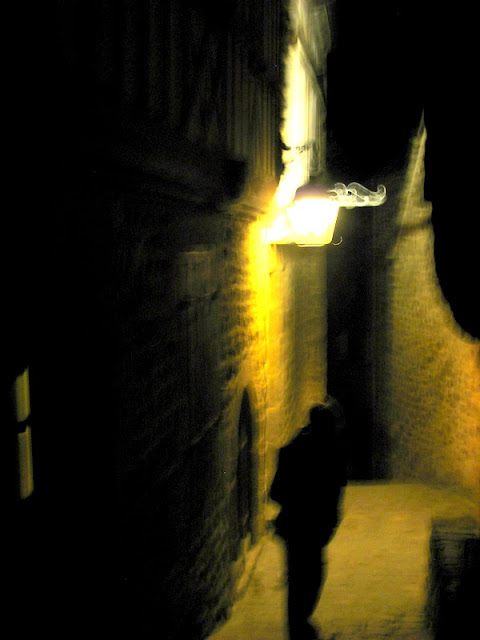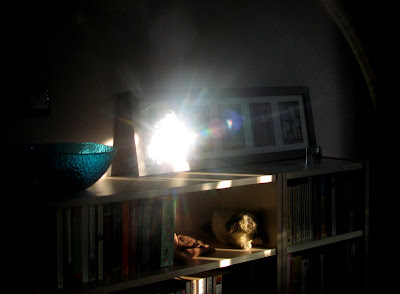
Any tendencies I once had towards political activism have been dormant for quite a while; quietism is more my line now, and I have felt generally unqualified to involve myself in the politics of my adoptive country, not to say regrettably lackadaisical about it.
However, when it comes to the seaweed...
You may well have heard about this, as the Anglo-saxon media has covered the subject quite a bit (and possibly rather more frankly than the French), so that friends of friends with a holiday business on the coast found that their British visitors are hesitant to book, and some who did come said that when they told people they were visiting the Breton coast they replied 'You're not going swimming are you?'
Brittany is the most heavily intensively farmed area of France, which is one of the largest agricultural producers in the world. All the pretty pastoralism and littoral beauty I wax lyrical about here is threatened and blighted by this fact. The romantic notion of the sturdy and independant French peasant farmer living a simple life close to nature is more and more of a pernicious fiction, and the power that the big farming lobby is large, aggressive and ugly.
60% of France's substantial pig production and 40% of that of veal and of poultry - I don't have the figures for dairy but that is significant too, is concentrated in this corner of the country. It generates vast amounts of nitrates, which wash through the soil and pollute the water table, which in turn pollutes the sea in the wide warm shallow bays of the area.
This causes an explosion of a soft green seaweed, which gets washed up on the beaches. It gets thicker and thicker, then forms a crust and rots underneath it. On top it looks like used toilet paper, below the putrefying substance generates a highly toxic sulphurous gas. Last year, two dogs who wandered out into it died as a result of inhaling this, this year in August on the bay on the other side of the peninsular near Lannion, a horse died and its rider was hopitalised. Then recently a worker in a process where the seaweed is collected and recycled into more fertiliser (we've seen it in the garden centre, branded as organic and 100% natural from the coasts of Brittany) also died as a result of contact with it. Courageous doctors in both the latter cases insisted on autopsies to establish that the seaweed gas was indeed the cause of death.
The best article in English I've found is one from the Independent, which is here (there is unfortunately some kind of script running on the page which may cause problems, but it should be possible to disable it). The depressing is that the piece is from 2001, and the only thing that has changed is that the problem is, if anything, worse, and it has been established that the gas is fatally toxic.
After the horse died, the Prime Minister, Francois Fillon, graciously descended to the place where it happened for about five minutes, but the government's response so far has been to promise more help to clean up the beaches, even investigating the possibility of collecting the weed at sea before it comes to land. Needless to say, this does not address the root of the problem. Meanwhile, authorisation continues to be given for further pig and poultry and dairy farms to produce food which the farmers complain they cannot sell at any kind of price that makes sense.
However, when it comes to the seaweed...
You may well have heard about this, as the Anglo-saxon media has covered the subject quite a bit (and possibly rather more frankly than the French), so that friends of friends with a holiday business on the coast found that their British visitors are hesitant to book, and some who did come said that when they told people they were visiting the Breton coast they replied 'You're not going swimming are you?'
Brittany is the most heavily intensively farmed area of France, which is one of the largest agricultural producers in the world. All the pretty pastoralism and littoral beauty I wax lyrical about here is threatened and blighted by this fact. The romantic notion of the sturdy and independant French peasant farmer living a simple life close to nature is more and more of a pernicious fiction, and the power that the big farming lobby is large, aggressive and ugly.
60% of France's substantial pig production and 40% of that of veal and of poultry - I don't have the figures for dairy but that is significant too, is concentrated in this corner of the country. It generates vast amounts of nitrates, which wash through the soil and pollute the water table, which in turn pollutes the sea in the wide warm shallow bays of the area.
This causes an explosion of a soft green seaweed, which gets washed up on the beaches. It gets thicker and thicker, then forms a crust and rots underneath it. On top it looks like used toilet paper, below the putrefying substance generates a highly toxic sulphurous gas. Last year, two dogs who wandered out into it died as a result of inhaling this, this year in August on the bay on the other side of the peninsular near Lannion, a horse died and its rider was hopitalised. Then recently a worker in a process where the seaweed is collected and recycled into more fertiliser (we've seen it in the garden centre, branded as organic and 100% natural from the coasts of Brittany) also died as a result of contact with it. Courageous doctors in both the latter cases insisted on autopsies to establish that the seaweed gas was indeed the cause of death.
The best article in English I've found is one from the Independent, which is here (there is unfortunately some kind of script running on the page which may cause problems, but it should be possible to disable it). The depressing is that the piece is from 2001, and the only thing that has changed is that the problem is, if anything, worse, and it has been established that the gas is fatally toxic.
After the horse died, the Prime Minister, Francois Fillon, graciously descended to the place where it happened for about five minutes, but the government's response so far has been to promise more help to clean up the beaches, even investigating the possibility of collecting the weed at sea before it comes to land. Needless to say, this does not address the root of the problem. Meanwhile, authorisation continues to be given for further pig and poultry and dairy farms to produce food which the farmers complain they cannot sell at any kind of price that makes sense.

(Trans: For a sustainable form of agriculture, reform the CAP)
Why? Subsidies. The Common Agricultural Policy ( CAP, or PAC in French, who turn all acronyms round!). Even if you can't sell it you make money just by producing it, X euros for every pig, or chicken or turkey, or veal-calf or whatever . The economist Jeffrey Sachs once said* "I have never mastered EU agricultural policy, because I figured if I did so it would drive me into such a surrealistic world that I might never climb out of that twilight zone again", so dense and intractible has the Policy become. But though the organisation of it may be diabolically complicated, the injustice of it isn't. Europe's not alone in this, all the developed world is at it.
(Trans: Holy cow, but it's complicated! Too much fertiliser = too much milk = crisis = pollution = poison seaweed. What are we going to do??? )
Then there's big agri-business, in whose interests it is to promote and maintain these ways of doing things.
Then there's big agri-business, in whose interests it is to promote and maintain these ways of doing things.

(Trans: For the water, we need another kind of agriculture)
The raising of livestock for food emits as much carbon and other greenhouse gases as transport, and only looks set to continue. In a world which is growing in population, 10 kilos of vegetable protein are required to produce one of mammal protein. The industrial livestock units are cruel, unhealthy, polluting, horrible places which we as a species ought to be ashamed to be responsible for. Most of us know all this.
Something is badly wrong with this situation. I get on well with my farming neighbours; I have little choice, but it isn't just that. I'm only two generations from the land myself, when hardship and failure and too many mouths drove my Somerset grandfather off it. No sight was sweeter to my father than a ploughed field, though he was always wary of bucolic nostalgia about life on the land before the industrialisation and mechanisation of agriculture, he knew how brutal and bitter it could be. I enjoy talking about farming matters, seeing land used contructively, the rhythm of the seasons, the space and patterning of human cultivation, all that. Though I've never had to get used to the harsh realities of it, and killing things, I'm fairly realistic and unsentimental about these facts. I am not a vegetarian, for a number of reasons, not only apathy and carnivorous greed. We've tried growing some of our own food, and though there's much to be said for it, it's led me to recognise that there's also much to be said for leaving it to the professionals, or at least for having a class of professionals whose job it is to do it on a larger scale in a systematised way.
I know that even quite big business farmers work very hard, often still in family concerns, which gives them a strong sense of ownership, take few holidays, and despite - or perhaps because of, since the whole matter is so utterly inefficient and dysfunctional - the system of subsidies, many are struggling to make anything worthwhile out of it. As far as I can gather the youngsters are all sent off to agricultural college that teaches them to do things according to the status quo, and until it's worth their while to do it another way they're not likely to. It's a hard life and they aren't going to voluntarily make it harder for themselves, not without a change in the incentives and disincentives.
And they aren't the only ones. While the organic/biologique market continues as a sideline, the majority of people are more than happy to pork out on cheap, factory produced pork and similar. Food is cheaper in real terms than it's ever been, (and pork is quite literally dirt cheap) but here and elsewhere, people are still grumbling about the perceived reduction in their pouvoir d'achat, their spending power. Which is, of course, real for many, but we also need to get real about the other costs of cheap food.
I could go on and on, but I have done so enough. Depressed by the indifference we have encountered from people we thought might have more to say about the issue, E. and I decided we would get more involved, and went along to a demonstration organised by the various environmental groups, including 'Halte aux Marées Vertes' ('Stop the Green Tides' , a reference to the 'Marées Noires' the 'Black Tides' of earlier oil slick pollution), at Hillion, where some of the worst green weed pollution is evident.
Being northern European, we arrived more or less at the scheduled time (though E, who is Dutch is a notoriously unpunctual person, which probably has nothing to do with nationality at all). This meant that nothing had really got started at all, and people were a bit thin on the ground. Nothing here really starts to happen until quite late in the afternoon.

However, the above gives a general impression of the meeting place, with the beach behind and the little St Maurice chapel in the distance. The red tractor trailer was the speakers' platform, and to the right was a bar and coffee stand, and... surely not, yes, they are grilling...
pork sausages!
'I can't believe it!' exclaimed E
'They're maybe special biologique, non-polluting, sustainably farmed pork sausages...' I suggested.
'I'm going to go and ask!'
And she did, adopting a somewhat inquisitorial attitude.
On learning that they were indeed magical and innocent sausages, E, who at 63 has maintained that figure largely through disregarding such unnecessary details as lunch, decided that she rather fancied one, but ate it straight, with neither frîtes nor galette, which earned her some puzzled looks.
Tom stayed home with Molly. His general lack of hearing and comprehension would have made it difficult, and I wasn't sure Mol would enjoy the crowds and waiting around either. though there were quite a few dogs, who probably weren't giving the cause their full attention.

Also, we were a little afraid that the seaweed intself might pose a threat for a dog, though in fact the beach had been immaculately cleaned by the environmentalists themselves, to make sure it was safe and also to show how it should look there. I've never seen it looking so beautiful.

As the afternoon went on, the numbers increased, and plenty of banners began to flutter. The red ones here are for the Nouveau Parti Anticapitaliste, Besancenot's new left alliance job. While the whole business certainly makes one feel decidedly anti-capitalist, if one didn't already, the old politics of left and right, with their focus on human society and endless economic growth often seem to miss the point, and the words 'bandwagon' and 'jumping', to say nothing of 'opportunistic' do rather come to mind... Still, apparently they've dropped their Trotskyite agenda, and consider themselves a feminist party, though they make no mention of patriarchy theory... oh go read the Wiki entry yourselves if you're interested!
Some of the press I read after described it as a demonstration by ecologists, which is fair enough, and yet many who were there didn't necessarily typically fit the profile, but were obviously just concerned ordinary members of the public. Indeed many were simply residents of Hillion, fed up with the blight on their beautiful beaches year after year and of having to pay for the clean-up.
I have to say though, I was heartened to see so many un-coiffed and untamed heads of natural grey hair, more than I think I've seen since I've lived here.

The T-shirt above was a puzzle; many banners, t-shirts etc were saying how unwanted pigs were, while this one says 'Welcome to the pig/pork'!

Above is André Ollivro, who began the campaign, and who is interviewed in the Independent article above. The campaign makes clear 'there is no question of stigmatising farmers, who, for the most part, are themselves the victims of the system'. However, some farmers haven't seen it that way, and took it on themsleves to dump large hay bales in his front garden so he couldn't leave his house. Petulant if not fatal.
His speaking was quite clear and interesting to us, but many of the speakers had a style of oratory which was quite monotonous and difficult to follow. E's French is better than mine (she is Dutch after all), but she found it hard too. So we hung around for an hour or two, signed all the petitions and paid up to join the campaign, then went on our way. Apparently later on they all went down to the beach and started to party, but, typical northern Europeans, we couldn't be doing with the long moment d'attente before the action, and missed it.
I gently chided the people from the Halte aux Marées Vertes campaign for their lack of internet presence; the newsletter isn't regularly updated and the website is fairly non-existent. They said they knew but they'd got someone who was going to bring it up to scratch. I'm thinking of
offering to translate for them so more English speakers can find out and get involved. It might be that a commitment to some very specific local green politics will be my way to growing out of my sense of apathy about and detachement from civic life here.
One banner of a pig's head and crossbones caught my eye.
In the background of the picture is the house of the philosopher Georges Palante, who lived in Hillion, and in fact taught lycee in St Brieuc, as I did for a very short while. (I hope he had a better time than I did!).
Though he once stood as a socialist candidate, Palante was sceptical of the movement, and a staunch individualist. According to the Wiki page on him
"His thinking (was) also critical towards the mass "herd instinct", which he thought oppresses and prevents individuals from developing fully. He did not, however, oppose social networks, and insisted that his philosophy did not seek to destroy society for the benefit of the individual, but to help to build new networks of social interaction."
Which sounds OK to me.

On the way out, we spotted this small philosopher, absorbed in what looked like some more serious words.
* in the International Herald Tribune in 2002, quoted in '50 facts that should change the world' by Jessica Williams.
~~~
I have more pictures from the holiday, which I will continue to post, but wanted to get this one done while it was still topical. I am aware these are complex issues, about which I don't pretend to know everything, or claim any particular moral high ground on, but have felt moved to say and (try to) do something about. Thanks for sticking with such a long post; there won't be any as long as this again for a while, as I have a dozen other things I should really be doing!












































.JPG)







